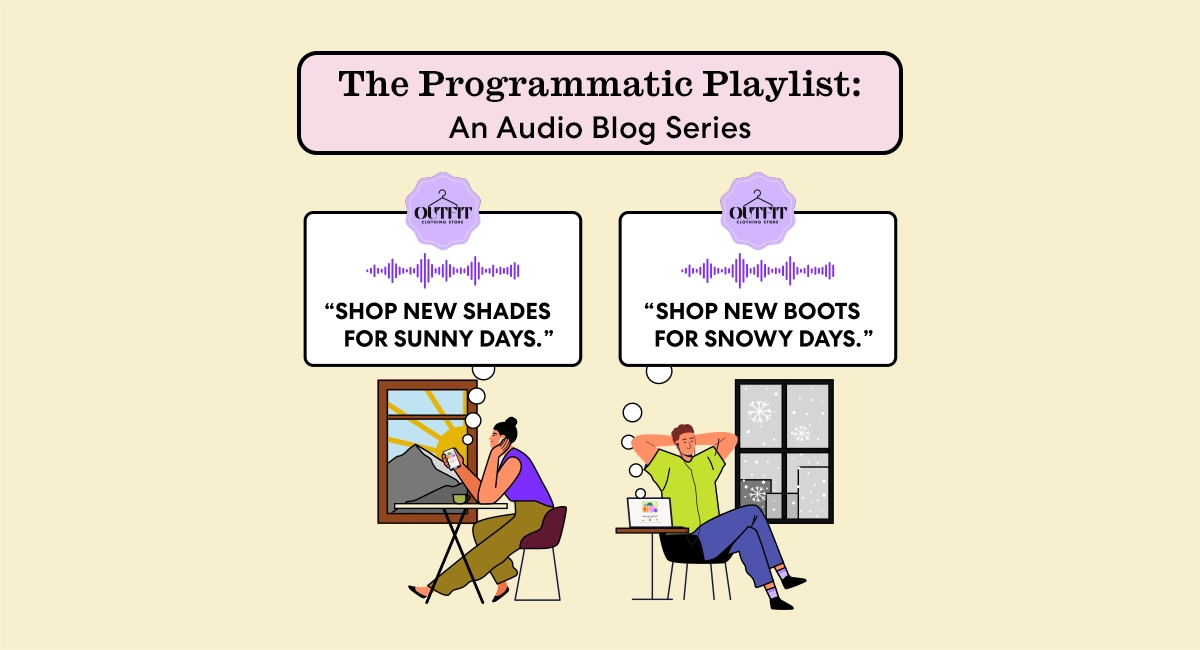
Blog / Insights
This is Track 2 of the Programmatic Playlist, a Yahoo DSP blog series exploring the rise of programmatic audio and the new and exciting opportunities it creates for advertising with music and podcasts.

Tom Ellis
Director, Yahoo Creative, Yahoo DSP EMEA

More and more of the public are streaming audio, with the average British consumer listening to 93 minutes of audio a day in 2025 (up by 29% vs 2020)1. With 40.1M digital audio listeners in the UK1, the majority of audio consumption is taking place while people are engaged in activities where traditional visual media cannot reach them2.
Audio aligns seamlessly with these activities, whether it is radio as our car companion on the morning commute or using on-demand music to change our mood. It is in these moments that audio can trigger emotional intensity and memory - driving engagement and representing a unique opportunity for brands to connect with consumers.
With brands scaling their campaigns across multiple touchpoints throughout the consumers day, advertisers are leaning on dynamic creative and consumers are craving more personalisation. With 23% of 16-34 year olds wanting to have messages specific to their shopping or browsing habits3, Audio advertising should be no stranger to dynamic personalisation and that is the case today. Audio creative doesn’t just interrupt content streams—it actively adapts to listeners in real time, delivering greater relevance, stronger campaign performance, and memorable experiences.
Why Dynamic Creative Matters in Audio
Audio ads with dynamic creative optimization are designed to respond to a listener’s context. Whether it’s their location, current time, mood, or even weather conditions, every play can feel tailor-made. With technology now powering decisions at scale, executions can seamlessly weave together contextual cues—like a rainy morning in Manchester or a sunny commute in London—with creative elements that match that moment.
But context is just the tip of the iceberg. Modern audio ads can personalise to a user's:
This real-time tailoring: updating the script, swapping offers and even changing the voice, commands attention. Tailored audio stands out from static messaging, keeps listeners engaged longer, and encourages more active brand responses.
Personalisation That Resonates
Personalised ads that react to listeners’ current experiences have a profound effect on engagement and ad recall. When an audio message reflects what a user is feeling, doing, or anticipating, it’s naturally more memorable. Contextually personalised ads embody empathy: matching energy with the moment for higher impact.
The Democratisation of Dynamic Audio: AI Voices vs. Voice Actors
Traditionally, producing tailored audio meant working with voice actors and managing complex recording schedules—a costly and time-intensive process. Now, AI-synthetic voices are unlocking access for brands of all sizes. Brands can select from a growing roster of lifelike voices, tweak scripts, and deploy thousands of creative variants in far less time and at a fraction of the cost. This opens the doors for wider experimentation, local market relevance, and adaptation at speed.
However, it’s not just about scale. AI-synthetic voices enable rapid script decisioning and version control, giving brands agility. Voice actors still play a vital role in premium narratives and human storytelling, but for brands focused on efficiency, cost, and speed4, synthetics are a game-changer. As tech companies continue to invest in AI, synthetic voices are continuously improving to the point where it becomes harder to recognise an actor vs. AI and this investment will only continually drive down cost and improve efficiency for brands to leverage AI for audio production.
Driving Creative Personalisation at Scale
The rise of dynamic audio is turbocharged by platforms offering automated creative personalisation and data-driven script decisioning. These capabilities depend on robust data pipelines—using not only audio context but also publisher first-party data. With platform integration, marketers can automate the selection, assembly, and delivery of personalized audio messages across channels and devices, making scalable DCO a reality.
The Future: Interactive Audio and Conversational Formats
Looking ahead, smart speakers and voice assistants are reshaping how audiences interact with audio. Users are engaging in hands-free, voice-powered routines—opening new territory for interactive, conversational audio ads.
Brands can now craft dynamic formats that not only respond to listener input but guide a two-way dialogue, inviting participation or customizing offers in real time. Creative teams are building for this future, investing in advanced voice intent detection, interactivity frameworks, and creative automation that bring even more nuance to every interaction.
Final Thoughts
The era of static audio is rapidly fading. Dynamic creative is poised to dominate, and brands and listeners are benefitting from ads that are contextually aware, personally relevant, and designed for interaction.
Sources:
²IAB, Digital Audio Buyer’s Guide, Nielsen Research
³DMA, Customer Engagement Future Trends, 2024
⁴The Drum, Listen up: why advertisers need to switch on to personalized audio ads, 2024
--
About Tom Ellis
Tom heads up the Yahoo Creative team for both EMEA & AUSEA. Yahoo Creative is a full-stack global creative solution that allows advertisers to take full advantage of a team of creative experts to help scale their omni-channel campaigns across the Yahoo DSP.